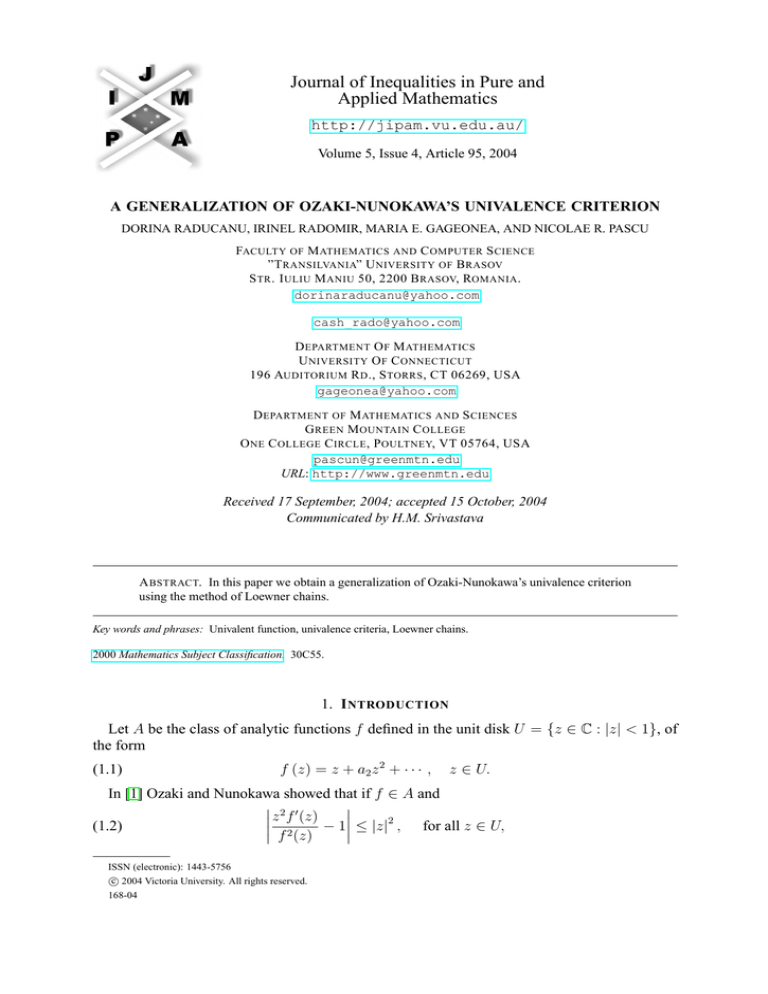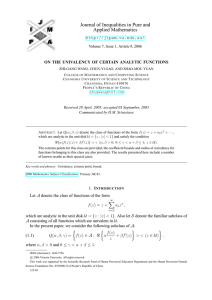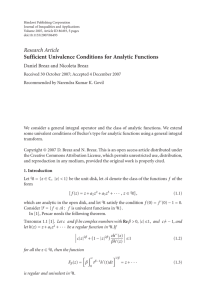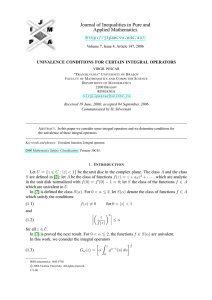
Journal of Inequalities in Pure and
Applied Mathematics
http://jipam.vu.edu.au/
Volume 5, Issue 4, Article 95, 2004
A GENERALIZATION OF OZAKI-NUNOKAWA’S UNIVALENCE CRITERION
DORINA RADUCANU, IRINEL RADOMIR, MARIA E. GAGEONEA, AND NICOLAE R. PASCU
FACULTY OF M ATHEMATICS AND C OMPUTER S CIENCE
”T RANSILVANIA” U NIVERSITY OF B RASOV
S TR . I ULIU M ANIU 50, 2200 B RASOV, ROMANIA .
dorinaraducanu@yahoo.com
cash_rado@yahoo.com
D EPARTMENT O F M ATHEMATICS
U NIVERSITY O F C ONNECTICUT
196 AUDITORIUM R D ., S TORRS , CT 06269, USA
gageonea@yahoo.com
D EPARTMENT OF M ATHEMATICS AND S CIENCES
G REEN M OUNTAIN C OLLEGE
O NE C OLLEGE C IRCLE , P OULTNEY, VT 05764, USA
pascun@greenmtn.edu
URL: http://www.greenmtn.edu
Received 17 September, 2004; accepted 15 October, 2004
Communicated by H.M. Srivastava
A BSTRACT. In this paper we obtain a generalization of Ozaki-Nunokawa’s univalence criterion
using the method of Loewner chains.
Key words and phrases: Univalent function, univalence criteria, Loewner chains.
2000 Mathematics Subject Classification. 30C55.
1. I NTRODUCTION
Let A be the class of analytic functions f defined in the unit disk U = {z ∈ C : |z| < 1}, of
the form
(1.1)
f (z) = z + a2 z 2 + · · · ,
z ∈ U.
In [1] Ozaki and Nunokawa showed that if f ∈ A and
2 0
z f (z)
2
(1.2)
f 2 (z) − 1 ≤ |z| , for all z ∈ U,
ISSN (electronic): 1443-5756
c 2004 Victoria University. All rights reserved.
168-04
2
D ORINA R ADUCANU , I RINEL R ADOMIR , M ARIA E. G AGEONEA , AND N ICOLAE R. PASCU
then the function f is univalent in U . In this paper we use the method of Loewner chains to
establish a generalization of Ozaki-Nunokawa’s univalence criterion.
2. L OEWNER C HAINS AND U NIVALENCE C RITERIA
In order to prove our main result we need a brief summary of Ch. Pommerenke’s method of
constructing univalence criteria. A family of univalent functions
L(·, t) : U −→ C,
t≥0
is a Loewner chain, if L(·, s) is subordinate to L(·, t) for all 0 ≤ s ≤ t. Recall that a function
f : U −→ C is said to be subordinate to a function g : U −→ C (in symbols f ≺ g) if there
exists a function ω : U −→ U such that f (z) = g(ω(z)) for all z ∈ U . We also recall the
following known result (see [4, pp. 159–173]):
Theorem 2.1. Let L(z, t) = a1 (t)z + . . . be an analytic function of z ∈ Ur = {z ∈ C : |z| < r}
for all t ≥ 0. Suppose that:
i) L(z, t) is a locally absolutely continuous function of t, locally uniform with respect to
z ∈ Ur ;
ii) a1 (t) is a complex-valued continuous function on [0, ∞) such that
a1 (t) 6= 0,
and
lim |a1 (t)| = ∞
t→∞
L(·, t)
a1 (t) t≥0
is a normal family of functions in Ur ;
iii) there exists an analytic function p : U × [0, ∞) → C satisfying
Re p (z, t) > 0,
for all (z, t) ∈ U × [0, ∞)
and
∂L(z, t)
∂L(z, t)
= p (z, t)
, for any z ∈ Ur , a.e. t ≥ 0.
∂z
∂t
Then for all t ≥ 0, the function L(·, t) has an analytic and univalent extension to the whole
unit disk U .
z
We can now prove the main result, as follows:
Theorem 2.2. Let f ∈ A and let m be a positive real number such that the inequalities
2 0
z f (z)
m+1
m
−
1
(2.1)
f 2 (z) − 1 − 2 < 2
and
2 0
z f (z)
m + 1 m+1
m
−
1
m+1
≤
(2.2)
−
1
−
|z|
|z|
f 2 (z)
2
2
are satisfied for all z ∈ U . Then the function f is univalent in U.
Proof. Let a and b be any positive real numbers chosen such that m = ab . We define:
f (e−at z)
bt
−at
e
−
e
z (e−at z)2
L(z, t) = f (e−at z) +
−at z)−e−at z ,
1 − (ebt − e−at ) z f (e (e−at
z)2
for t ≥ 0. Since the function f (e−at z) is analytic in U , it is easy to see that for each t ≥ 0
there exists an r ∈ (0, 1] arbitrarily fixed, the function L(z, t) is analytic in a neighborhood Ur
J. Inequal. Pure and Appl. Math., 5(4) Art. 95, 2004
http://jipam.vu.edu.au/
A G ENERALIZATION O F O ZAKI -N UNOKAWA’ S U NIVALENCE C RITERION
3
of z = 0. If L(z, t) = a1 (t)z + · · · is the power series expansion of L(z, t) in the neighborhood
Ur , it can be checked that we have a1 (t) = ebt and therefore a1 (t) 6= 0 for all t ≥ 0 and
is the summation between z and a holomorphic function,
limt→∞ |a1 (t)| = ∞. Since L(z,t)
a1 (t)
n
o
L(·,t)
it follows that a1 (t)
is a normal family of functions in Ur . By elementary computations
t≥0
it can be shown easily that ∂L(z,t)
can be expressed as the summation between bebt z and a
∂z
holomorphic function. From this representation of ∂L(z,t)
we obtain the absolute continuity
∂z
requirement i) of Theorem 2.1. Let p(z, t) be the function defined by
∂L(z, t) ∂L(z, t)
p(z, t) = z
.
∂z
∂t
In order to prove that the function p(z, t) is analytic and has a positive real part in U , we will
show that the function
p(z, t) − 1
(2.3)
m(z, t) =
p(z, t) + 1
is analytic in U and
|m(z, t)| < 1
(2.4)
for all z ∈ U and t ≥ 0. We have
m(z, t) =
(1 + a)F (z, t) + 1 − b
,
(1 − a)F (z, t) + 1 + b
where
0 −at
z)
−at 2 f (e
F (z, t) = e
(e z) 2 −at − 1 .
f (e z)
The condition (2.4) is therefore equivalent to
a+b
b
−
a
F (z, t) −
<
(2.5)
, for all z ∈ U and t ≥ 0.
2a 2a
(a+b)t
For t = 0, the inequality (2.5) becomes
2 0
z f (z)
m+1
m
−
1
<
−
1
−
,
f 2 (z)
2 2
b
where m = . Defining:
a
(a+b)t
G(z, t) = e
0 −at
z)
m−1
−at 2 f (e
(e z) 2 −at − 1 −
f (e z)
2
and observing that |e−at z| ≤ e−at < 1 for all z ∈ Ū = {z ∈ C : |z| ≤ 1} and t > 0, we obtain
that G(z, t) is an analytic function in Ū . Using the Maximum Modulus Principle it follows that
for each t > 0 arbitrarily fixed there exists θ ∈ R such that:
|G(z, t)| < max |G(z, t)| = G(eiθ , t) ,
|z|=1
for all z ∈ U . Let u = e−at eiθ . We have |u| = e−at , e−(a+b)t = (e−at )m+1 = |u|m+1 , and
therefore
2 0
1
u
f
(u)
m
−
1
iθ
G(e , t) = .
−
1
−
|u|m+1
f 2 (u)
2 J. Inequal. Pure and Appl. Math., 5(4) Art. 95, 2004
http://jipam.vu.edu.au/
4
D ORINA R ADUCANU , I RINEL R ADOMIR , M ARIA E. G AGEONEA , AND N ICOLAE R. PASCU
From the hypothesis (2.2) we obtain therefore:
G(eiθ , t) ≤ m + 1 .
(2.6)
2
From (2.1) and (2.6) it follows that the inequality (2.5) holds true for all z ∈ U and all t ≥ 0.
Since all the conditions of Theorem 2.1 are satisfied, we obtain that the function L(·, t) has an
analytic and univalent extension to the whole unit disk U , for all t ≥ 0. For t = 0 we have
L(z, 0) = f (z), for all z ∈ U , and therefore the function f is univalent in U , concluding the
proof of the theorem.
It is easy to check that inequality (2.2) implies the inequality (2.1) and thus we obtain the
following corollary :
Corollary 2.3. Let f ∈ A and let m be a positive real number such that
2 0
z f (z)
m − 1 m+1 m + 1 m+1
(2.7)
f 2 (z) − 1 − 2 |z|
≤ 2 |z|
for all z ∈ U . Then the function f is univalent in U .
Remark 2.4. We conclude with the following remarks:
i) In the particular case m = 1, condition (2.7) of the above corollary becomes condition
(1.2). Therefore, we obtain Ozaki-Nunokawa’s univalence criterion as a particular case
(m = 1) of the above corollary, which generalizes it to all positive real numbers m > 0.
z
satisfies the condition (2.7) of the above corollary for every
ii) The function f (z) =
1+z
positive real number m > 0.
R EFERENCES
[1] S. OZAKI AND M. NUNOKAWA, The Schwarzian derivative and univalent functions, Proc.
Amer. Math. Soc., 33(2) (1972.)
[2] N.N. PASCU AND V. PESCAR, A generalization of Pfaltzgraff’s theorem, Seminar of Geometric Function Theory (Preprint), 2 (1991), 91–98.
[3] J. PFALTZGRAFF, K−Quasiconformal extension criteria in the disk, Complex Variables, 21
(1993), 293–301.
[4] Ch. POMMERENKE, Uber die Subordination analytischer Funktionen, J. Reine Angew. Math.,
218 (1965).
J. Inequal. Pure and Appl. Math., 5(4) Art. 95, 2004
http://jipam.vu.edu.au/












